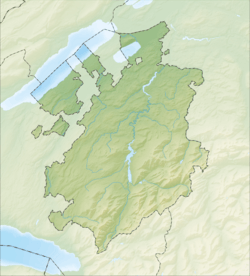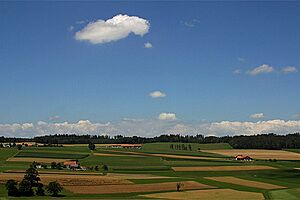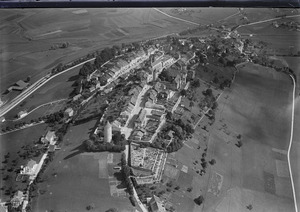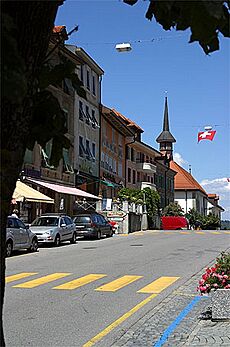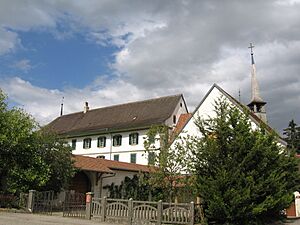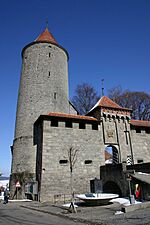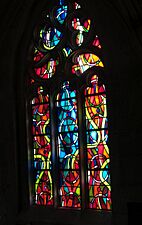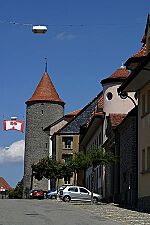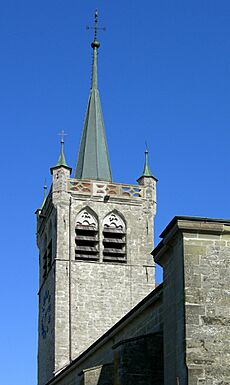Romont facts for kids
Quick facts for kids
Romont
|
||
|---|---|---|
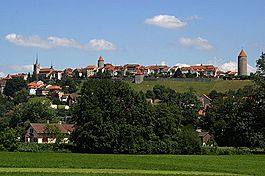 |
||
|
||
| Country | Switzerland | |
| Canton | Fribourg | |
| District | Glâne | |
| Area | ||
| • Total | 10.89 km2 (4.20 sq mi) | |
| Elevation | 780 m (2,560 ft) | |
| Population
(Dec 2020 )
|
||
| • Total | 5,417 | |
| • Density | 497.43/km2 (1,288.3/sq mi) | |
| Postal code |
1680
|
|
| Surrounded by | Billens-Hennens, Dompierre (VD), La Folliaz, Mézières, Prévonloup (VD), Sédeilles (VD), Siviriez, Villars-Bramard (VD), Villaz-Saint-Pierre | |
Romont is a town in Switzerland. It is the main town of the Glâne district in the canton of Fribourg. Romont is known for its history and beautiful old buildings.
Contents
- Romont's Story: A Look Back in Time
- Romont's Location and Landscape
- Romont's Symbol: The Coat of Arms
- Who Lives in Romont?
- Important Places to See in Romont
- Romont's Twin Town
- How People Work in Romont
- Religions in Romont
- Romont's Weather
- Learning in Romont
- Getting Around Romont
- Notable People
- Images for kids
- See also
Romont's Story: A Look Back in Time
Romont was first mentioned in old writings in 1177. Back then, it was called in Rotundo Monte. Later, in 1244, it was called Romont. There was also a German name, Remund, but it's not used anymore.
People have lived in the Romont area for a very long time. Scientists have found five ancient burial mounds from the Hallstatt culture in a village called Bossens. They also found parts of a Roman-era building.
A story says that King Rudolph II founded Romont in 921. But this is probably just a legend. In 1239, a man named Anselme sold his rights to Romont hill to Peter II of Savoy. At that time, the area belonged to the Bishop of Lausanne.
In 1240, Peter II sent someone to Romont to build a castle and start a village. A few years later, in 1244, an agreement called the Peace of Evian confirmed that Savoy owned Romont. The main castle, called Grand Donjon, was finished before 1260. It had a typical square shape like other castles built by Savoy. Part of this castle fell down in 1579, but it was rebuilt in 1591.
Another castle tower, now called the Boyer-tower, was built around 1250–1260. It has a round shape. The town also had a wall around it with three gate towers. These walls were taken down between 1842 and 1854. Between 1843 and 1865, five big fires destroyed the old center of town. New, more modern buildings were built in their place.
Romont was a very important city in the Vaud region. By the late 1200s, over 1,000 people lived there. Before the Burgundian Wars in 1474, nearly 1,500 people lived in Romont. It was a key place for trade and travel between Fribourg and the Savoy lands near Lake Geneva. Romont was given special town rights, like the town of Moudon, by 1328 at the latest.
During the Burgundian Wars, the cities of Bern and Fribourg attacked and burned Romont twice. Romont stayed loyal to its Savoy rulers until 1536. At that time, Bernese troops, who were Protestant, took over Vaud. Romont was able to team up with Catholic Fribourg and keep its traditional Catholic faith.
Romont was the capital of the Romont area until 1798. Then it became the capital of a district until 1803. During a conflict called the Stecklikrieg in 1802, Romont supported the Helvetic Republic, which was a government in Switzerland at the time. From 1803 to 1848, it was the capital of the Romont prefecture. After that, it became the capital of the Glâne district, which it still is today.
Romont's Location and Landscape
Romont covers an area of about 10.9 square kilometers (about 4.2 square miles). Most of this land, about 67.2%, is used for farming. Forests cover about 13.6% of the area. The rest, about 19.0%, has buildings or roads. A very small part, 0.3%, is made up of rivers or lakes.
The town is located where roads from Fribourg, Lausanne, and Bulle meet. It is also right on the border with the Canton of Vaud.
Romont's Symbol: The Coat of Arms
A coat of arms is a special design that represents a town or family. Romont's coat of arms shows a red background. On it, there is a silver castle with black lines and a gate. The tower on the right side of the castle is taller than the one on the left. At the top, there is a small red shield with a silver cross.
Who Lives in Romont?
Romont has a population of about 5,000 people. About 33.5% of the people living in Romont are from other countries. Over the past 10 years (2000–2010), the population grew by about 13.7%. Most of this growth was from people moving to Romont.
Most people in Romont (about 83.8%) speak French as their main language. Portuguese is the second most common language (6.2%), followed by German (2.3%).
In 2008, about 49.7% of the population was male and 50.3% was female. About 30.5% of the people living in Romont in 2000 were born there. Another 28.1% were born in the same canton (Fribourg). About 25.9% were born outside of Switzerland.
Children and teenagers (0–19 years old) make up about 25.2% of the population. Adults (20–64 years old) make up 61.3%, and seniors (over 64 years old) make up 13.5%.
In 2000, there were 1,667 homes in Romont. On average, there were 2.3 people living in each home. About 609 homes had only one person, and 140 homes had five or more people.
Important Places to See in Romont
Romont has several places that are considered important heritage sites. These are special places that are protected because of their history or beauty. The whole village of Romont is also part of the Inventory of Swiss Heritage Sites.
Some of these important sites include:
- The Trappist Abbaye de la Fille-Dieu, which is a type of monastery.
- Romont Castle, a historic castle.
- The Vitromusée/Musée suisse du vitrail et des arts du verre, which is a museum about stained glass and glass art.
- The collegiate church of Notre-Dame de l’Assomption, a large church.
- The town's old walls and defenses.
Romont's Twin Town
Romont has a special friendship with another town called a "twin town." This means they share ideas and culture. Romont's twin town is:
|
How People Work in Romont
In 2010, the unemployment rate in Romont was 5.7%. This means that 5.7% of people who wanted to work could not find a job.
Many people in Romont work in different types of jobs:
- About 100 people work in the primary sector. This includes jobs like farming and forestry.
- About 1,109 people work in the secondary sector. These jobs include manufacturing (making things in factories) and construction (building things).
- About 1,714 people work in the tertiary sector. This sector includes jobs in services, like sales, transportation, hotels, restaurants, education, and healthcare.
In 2000, 1,686 workers came into Romont for their jobs, and 924 workers left Romont to work elsewhere. This means more people come into Romont for work than leave it. About 13.1% of working people used public transportation to get to work, and 60.6% used a private car.
Religions in Romont
According to a survey in 2000, most people in Romont are Roman Catholic (71.7%). About 6.4% belong to the Swiss Reformed Church. There are also people who belong to Orthodox churches (3.03%) and other Christian churches (1.94%). About 6.38% of the population is Islamic. Some people (4.41%) do not belong to any church, and others (6.89%) did not answer the question.
Romont's Weather
Romont usually has about 131.5 days of rain or snow each year. On average, it gets about 1256 millimeters (about 49 inches) of rain or snow annually. The wettest month is June, with about 129 millimeters (5 inches) of rain or snow over 11.7 days. May has the most days with precipitation, averaging 14.2 days, but with slightly less rain. The driest month is February, with about 81 millimeters (3 inches) of precipitation over 10.6 days.
Learning in Romont
In Romont, about 27.3% of the population has finished upper secondary education. This is schooling after middle school. About 9.0% have gone on to higher education, like university.
The schools in Fribourg canton have a system that starts with one year of optional Kindergarten. Then, students go to Primary school for six years. After that, they have three years of lower Secondary school. In lower Secondary, students are grouped by their abilities. After lower Secondary, students can choose to go to a three or four-year upper Secondary school. This can be a gymnasium (which prepares them for university) or a vocational program (which teaches job skills). After upper Secondary, students can go to a higher school or start an apprenticeship (on-the-job training).
During the 2010–11 school year, 1,569 students were in 86 classes in Romont. There were 153 kindergarten students, 316 primary students, and 917 lower secondary students. There were also 66 upper secondary students and 117 specialized higher education students.
In 2000, 759 students came to Romont to go to school from other towns. At the same time, 149 students from Romont went to schools outside the town.
Getting Around Romont
Romont has a railway station called Romont FR. Trains from this station can take you to places like Geneva Airport, Lucerne, Bern, Bulle, Allaman, and Fribourg/Freiburg.
Notable People
Some famous people connected to Romont include:
- A. F. P. Hulsewé (1910 – 1993 in Romont): A Dutch expert on China, who lived in Romont from 1975.
- Pierrette Micheloud (1915 in Romont – 2007): A Swiss writer and painter who was born in Romont.
- Pierre Hemmer (1950–2013): An important person in the early days of the internet. His father became a citizen of Romont in 1923.
Images for kids
See also
 In Spanish: Romont (Friburgo) para niños
In Spanish: Romont (Friburgo) para niños




